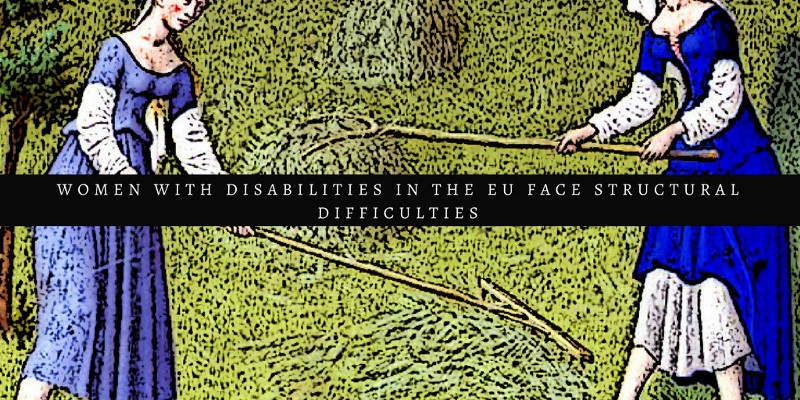Report finds women with disabilities in the European Union face poverty, unemployment, eugenics
Report finds women with disabilities in the European Union face poverty, unemployment, eugenics

This week the European Parliament released a report about Discrimination and access to employment for female workers with disabilities. The study, a first of its kind, “analyses whether and how the EU legislative and national policy frameworks address the multiple discrimination faced by women with disabilities. This combines a gender mainstreaming approach, such as the internalisation of a gender perspective in all disability policies and legislation, with specific measures targeted to women with disabilities”.
While the report repeatedly uses the the UN Beijing Platform for Action for Equality framework of “‘multiple discrimination’, as the ‘multiple barriers’ women and girls face … to their empowerment and advancement because of such factors as their race, age, language, ethnicity, culture, religion or disability or because they are indigenous people”, there is still no breakdown of the compounded racial + gender + disability barriers encountered by women with disabilities. There is also a complete absence of reporting on the issues faced by trans women with a disability. To be clear: the report itself fails to uphold the framework it claims to use in the analysis of the situation.
The most glaring moment of erasure in the report is perhaps this quote: “The greater vulnerability of disabled women can thus be understood through an intersectional perspective as simultaneous discrimination relating to disability and gender” and yet, they use a theory created by a Black scholar, further theorised and advanced by other Black women, often used by Black and other WoC and completely erase race from the equation.
That said, the report offers some insight into the structural issues faced by women with disabilities across the European Union. Here’s an overview of the salient points:
- 44 million people aged between 15 and 66 have a disability; 54% of people with a disability are women.

- the European Union has neither mainstreamed a disability perspective in its gender policies and programmes, nor adopted a gender perspective in its disability strategies.
- Access to social and health services is highlighted as a problematic area for women with disabilities in Europe: women with disabilities in fact face a significant number of barriers in accessing health and social services that can be related to physical accessibility, limited adaptability of health services in the field of motherhood, sexuality and reproductive
health, and lack of trained professionals. Furthermore, women with disabilities typically receive health services that are rarely targeted specifically at them.
Again, given studies that point to the differences of quality of healthcare received by migrants, ethnic minorities, PoC, etc the absence of racial breakdowns in this report cannot be overstated.
- Eugenics are still in practice: In some countries, prejudices against women and girls with disabilities result in widespread denial of their right to experience their sexuality, to create families and have children. Forced sterilisation, especially in the case of institutionalised women, is often performed under the auspice of legitimate medical care (including prevention of pregnancy resulting from sexual abuse)
- The denial of reproductive rights also involves the exclusion of women with disabilities from comprehensive reproductive and sexual healthcare, poorly managed and assisted pregnancy and birth and the denial of rights to parenting.
- Women with disabilities also face education gaps not only in relation to men but also to women without disabilities: “At the EU level, on average more than two out of five (40.6 %) women having a basic activity difficulty attained only pre-primary, primary and lower secondary education levels compared to around 28 % of women without a difficulty. Women having a basic activity difficulty are also disadvantaged with respect to men with the same difficulty, with a gender gap of about 4 percentage points”.
- Disability represents a barrier, for both women and men, in accessing the labour market. At the EU level, only 43.9 % of women with difficulties in basic activities are employed and even less (36 %) among those with an employment disability (an “employment disability” is defined in the report as “limited in work activity because of a long-standing health problem and/or a basic activity difficulty”).
- The countries with the lowest disability gaps are France, Sweden, Italy, Malta, Latvia and Finland. However, while the low disability gap registered in Sweden may be ascribed to the capacity of this country to ensure high employment rates for both women with and without disabilities, in the case of Italy and Malta the opposite is true, and the relatively low disability gaps result from the very low employment rates of women in general.
- On average, men with disabilities leave their jobs for health problems more often than women with disabilities
- More than half of the working-age population of women with disabilities, are inactive. Hence they are at a higher risk of economic and social marginalisation compared to both women without disabilities and men with disabilities.
- One-third (31 %) of women with a disability over 16 years old in the EU is at risk of poverty or social exclusion.
- Almost one third of young women with disabilities in the European Union are ‘not in education, employment or training’.
- In all Member States, the severe material deprivation rate is higher for women with, than for women without a disability.
- On average, women with disabilities are more likely to be affected by an inability to meet unexpected financial expenses than men with disabilities and women without.
- In 2014, 13.3 % of female adults with disability lived in households which had fallen behind with their payments (for mortgage or rent, utility bills or hire purchase) in the last 12 months, compared with 11.4 % of the female adult population with no disabilities.
- Women with disabilities are more likely to work part-time and from home than both women without and men with disabilities.
- The glass ceiling is particularly stringent for women with disabilities. They are less likely to be employed in high and medium skilled occupations compared to both men with disabilities and women without.
- The current government in Poland is not willing to discuss the topic of disabilities in the context of gender as it is officially recognised by them as unjustified and even harmful, because it stems from ideological premises.
- Across the European Union there is a lack of political representation of people with disabilities, especially women.
In closing, the report offers further observations and recommendations:
- The discrimination and marginalisation of women with disabilities has been largely neglected both in policymaking and in the disability and gender equality research and debate. Even feminist movements and disability movements have not explicitly considered women with disabilities and have paid only a scant attention to the question.
- the attention to the multiple discrimination women with disabilities are likely to suffer remains essentially out of the public and political debate, and the intersectional approach remains mostly a field for researchers and academic debate.
Again, I have to insist, this from a report that fails to meet its own standards neglecting to include how race impacts women with disabilities further and completely erasing the issues faced by trans women with disabilities.

I am an independent writer with no affiliations. If you find value in the type of work I do, please consider making a donation. Any funds, no matter how small will allow me to continue this ongoing research and analysis. Follow me on Twitter for daily updates.
For the past decade and a half I have been making all my content available for free (and never behind a paywall) as an ongoing practice of ephemeral publishing. This site is no exception. If you wish to help offset my labor costs, you can donate on Paypal or you can subscribe to Patreon where I will not be putting my posts behind a lock but you'd be helping me continue making this work available for everyone. Thank you. Follow me on Twitter for new post updates.

